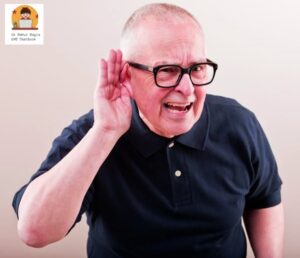PRESBYCUSIS (Age related hearing loss or age-associated hearing loss). Age-related hearing loss may be defined as a progressive bilateral sensorineural hearing loss of mid to late adult onset, where underlying causes have been excluded. Presbycusis is usually symmetrical and it is the most common cause of hearing loss in elderly patients of age around 65 years.

Major risk factors:
- Environmental factors (Noise exposure, cigarette smoking and alcohol intake).
- Hereditary factors.
- Associated comorbidities (Hypertension, blood hyper viscosity and cardiovascular and cerebrovascular disease).
Age-related changes.
- External ear. There can be enlargement of the pinna, increased hair growth, increased wax production, reduced epithelial migration, ear canal may be collapsed.
- Middle ear. There can be stiffening, thinning, loss of vascularity of tympanic membrane. Ossification may be present on ossicles and ossicular joints. Degeneration of middle ear muscles and calcification of cartilaginous support of eustachian tube may also be present.
- Inner ear. There are structural changes in the inner ear, sustained as a result of degenerative changes due to the ageing process. It is the main reason behind resultant hearing loss.
Schuknecht et al. based on histopathological studies hypothetically divided the inner ear changes into six distinct types.
- Sensory. This is characterized by loss of hair cells and sustentacular cells of the organ of Corti, starting at the basal turn of cochlea affecting higher frequencies first. Then it progresses gradually to the apex affecting lower frequencies. Higher frequencies are always more affected but speech discrimination remains good.
- Neural. This is characterized by degeneration of the cochlear nerve neurons and loss of spiral ganglion cells. Neurons of higher auditory pathways in the brain, right up to the cerebral cortex may also be affected. Similar to sensory type, there are higher frequencies involved but speech discrimination is low or poor and out of proportion to the pure tone loss. Being neural lesion, there is low SISI score (less than 30%), an abnormally high tone decay (usually above 15 dB).
- Strial or Metabolic or Vascular. There is atrophy of stria vascularis in all turns of the cochlea. There is also loss of strial tissue mainly in the apical and middle turns of the cochlea. The physical and chemical processes of energy production are affected. It runs in families. Audiogram is flat but speech discrimination is good. Recruitment test shows cochlear lesion, high SISI score (above 60%), normal tone decay test (tone decay of 15 dB or less).
- Cochlear Conductive or Mechanical. There is stiffening of the basilar membrane of the cochlea thus affecting movement of the membrane. There is also increase in the number of fibrillar layers of the basilar membrane. PTA shows typical ski-sloped audiogram with slope to the right.
- Intermediate: There are changes in the cochlear duct at sub microscopic level. There can also be changes in the intracellular organelles which are involved in cell metabolism. Furthermore there can be changes in endolymph composition and reduction in synapse numbers.
- Mixed: A combination of the other five subtypes
Clinical Features:
- Hearing loss. Patient will describe hearing difficulties which is gradual in onset and progressive in nature, especially presence of background noise. There is lack of clarity of sound rather than decreased hearing.
- Tinnitus: It can be presenting complaint of the patient. It frequently accompany hearing loss.
- Recruitment phenomenon: There may be abnormal growth in the perception of loudness by an individual causing discomfort in hearing.
- Other symptoms. Hearing loss may lead to increased incidence of falls, social isolation, depression, dementia and anxiety.
Investigations. Pure tone audiogram. There will be mild high frequency hearing loss in initial stages. Mid and lower frequencies may get involved as the disease advances. Bilateral sloping (descending) curve may be present.
Treatment.
- Psychological. Counselling of the patient. Family and friends are advised to have face-to-face conversation with visual cues and reduction of background noise.
- Specific. Binaural hearing aids for hearing loss. Tinnitus should be treated with tinnitus retraining therapy. Curtailment of smoking and stimulants like tea and coffee.
———— End of the chapter ————
Learning resources.
- Scott-Brown, Textbook of Otorhinolaryngology Head and Neck Surgery.
- Glasscock-Shambaugh, Textbook of Surgery of the Ear.
- Logan Turner, Textbook of Diseases of The Nose, Throat and Ear Head And Neck Surgery.
- P L Dhingra, Textbook of Diseases of Ear, Nose and Throat.
- Hazarika P, Textbook of Ear Nose Throat And Head Neck Surgery Clinical Practical.
- Mohan Bansal, Textbook of Diseases of Ear, Nose and Throat Head and Neck surgery.
- Anirban Biswas, Textbook of Clinical Audio-vestibulometry.
- W. Arnold, U. Ganzer, Textbook of Otorhinolaryngology, Head and Neck Surgery.
Author:

Dr. Rahul Kumar Bagla
MS & Fellow Rhinoplasty & Facial Plastic Surgery.
Associate Professor & Head
GIMS, Greater Noida, India
msrahulbagla@gmail.com
